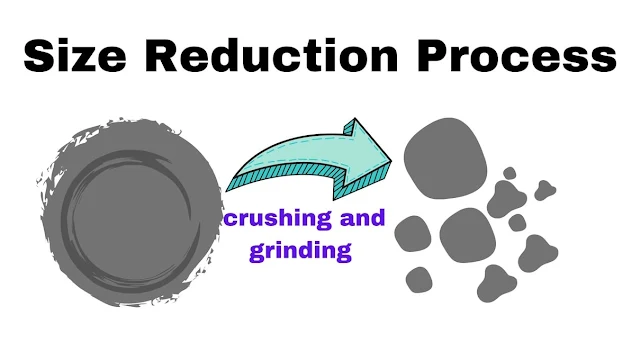Size reduction refers to an operation wherein particles of solids are cut or broken into smaller. Size reduction is a mechanical process of breaking down solids into smaller size particles without altering the state of aggregation of solids. It is also called comminution.
Many solid materials exist/present in sizes that are too large to be used directly. Thus, such materials must be reduced in size (before use).
{tocify} $title={Table of Contents}
Required (Necessary) Size Reduction
In the process industries, this operation is usually carried out in order-
(i) to increase the surface in order to increase the rate of a physical or chemical process. In most reactions and unit operations (e.g. leaching) involving solid particles, the rate increases by increasing the area of contact between the solid and the second phase since they are proportional to the area of contact between the phases involved.
In a combination process, the rate of combustion is proportional to the area presented to the gas. Thus, the rate of combustion of solid particles is high if the particles are of small size.
In leaching, the rate of extraction increases because of the increased area of contact between the solid and the solvent.
(ii) to effect the separation of two constituents in the case where one is dispersed in small isolated pockets.
(iii) to meet stringent specifications regarding the size of commercial products.
(iv) to accomplish intimate mixing of solids in a solid-solid operation since the mixing is more complete if the particle size is small.
(v) to improve dissolution rate, solubility, binding strength, and dispersion properties.
Size reduction machines more commonly reduce the size of solids by
(a) compression
(d) impact
(c) attrition or rubbing
(d) cutting.
In general, compression is used for the coarse reduction of hard solids, impact gives coarse, medium, or fine products, attrition gives very fine products from soft, non,-abrasive materials, and cutting produces a product of a definite particle size, and sometimes a definite shape, with few or no fines.
Size Reduction Uses
Size reduction operation is carried out in coal washeries, ore processing industries, chemical industry, Paint industry, cement industry, and food processing industry.
In the food industry - sugar, spices, grains, etc.
In the cement industry - lime, aluminum, sand, and cement clinker.
In the paint industry - pigments.
In the fertilizer industry - raw phosphate rock must be reduced in size.
Energy and Power for Size Reduction
The cost of power is the major expense in crushing and grinding operations. Thus, accurate estimation of the energy required is important in the design and selection of size-reduction equipment.
During size reduction, the solid particles are first distorted and strained, work required to strain them is stored temporarily in the solids as mechanical energy of stress. By applying sudden rupture into fragments. Thus, a new surface is generated. As a unit area of a solid has a definite amount of surface energy, the generation of a new surface requires work, which is given by the release of energy of stress when the particles break. The energy of stress in excess of the new surface energy created appears as heat.
It is not possible to estimate accurately the power requirement of crushing and grinding equipment to effect the size reduction of a given material, but a number of empirical laws have been put forward e.g. Rittinger's law, Kick's law, and Bonds law.
Take these Notes is, Orginal Sources: Unit Operations-II, KA Gavhane

